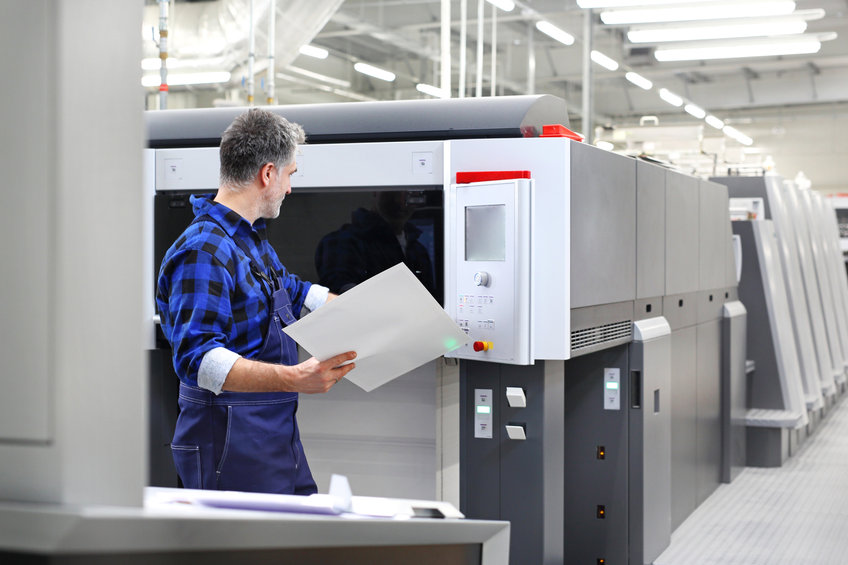Printing refers to the process of impressing letters, designs, or figures on different materials and surfaces such as paper, fabric, wood, vinyl, and cardboard. Printing has a long history of revolutionizing the transfer of ideas onto tangible items that can be distributed or shared with the public. It has evolved over the recent years, giving businesses the option to choose a printing technique that best highlights their brand. This article looks at the major types of printing that are available to creators and what they are used for.
- Offset Printing (Lithographic)
This type of printing is commonly used to print newspapers, magazines, books, brochures, and stationery.
It transfers an inked image from a plate to a rubber blanket before it can be printed on the surface itself. Offset printing is ideal for high-volume print runs making it a great choice for most media companies. It uses special custom inks and produces the highest quality print. The only downside is that the equipment requires a tedious setup and extra maintenance.
- Letterpress
Letterpress remained popular as a method for printing newspapers until the mid-twentieth century when it was replaced by offset printing. It involves the use of physical letters placed opposite on the raised area that is covered with ink before being transferred onto a substrate like paper. It is used for business cards, greeting cards, and posters. Letterpress printing is straightforward but is only good for a short print run due to its slow process, color limitations, and ability to produce images.
- Screen Printing
Screen printing is ideal for textiles and posters because of the versatile technique it uses to transfer quality designs onto fabrics. Paint is forced through silkscreen using a squeegee to allow it to settle on the desired areas. Beneath the silkscreen is a stencil with pre-made lettering or design that intend to transfer to the substrate. The only downside of screen printing is that it has limited color options and requires specialist equipment.
- Digital Printing
Digital printing is a modern method of printing that reproduces digital images onto physical surfaces such as paper or cardboard. Images are sent directly from a computer, tablet, or smartphone to an inkjet printer using digital files like PDF, or JPEG. Since digital printing eliminates the need for a printing plate, it is considered more time-efficient and budget-friendly printing. Not only does it produce high-quality print but also offers a quick turnaround than most printing methods.
- Flexography (flexo)
Flexography is a type of printing that is most often used for packaging. It uses semi-liquid inks that dry very quickly making it ideal for high-volume jobs. Flexography printing was originally used to print designs on corrugated cardboard. It has a flexible printing plate that maintains contact with uneven surfaces and thus is commonly used for packaging and labels. You can also use flexography to print on anything with continuous patterns like gift-wraps and wallpaper.
- Gravure
This type of printing is also known as Rotogravure printing. Gravure is a high-speed and quality printing method that produces fine, detailed images. Gravure printing engraves an image onto a copper cylinder and uses a rotary printing press like offset and flexography. Rotary gravure presses are known to be the widest and fastest in operation used for high-volume printing of wallpapers, packaging, and gift-wraps. Although less common, it can be used for printing high-volume advertising pieces, greeting cards, and magazines.
- 3D Printing
3D printing is a modern type of printing that is suitable for product design and sculpting. Although it is a newcomer in the world of printing, it is slowly making its way to the top by delivering incredible results that no one knew were possible. 3D printing uses a sophisticated type of printer to add material layer by layer until it forms the desired shape. Unlike other types of printing, 3D printers are fully customizable and capable of complex designs. It can be used for art, prototyping, models, and gifts. Some of the downsides of exploring the 3D printing world include limited materials, slow speeds, and the costly nature of accessing the printer technology.
Many creators and business owners are adopting new ways of printing to stay competitive in today’s market. Ecommerce business owners prefer a versatile printing solution that can print on different types of surfaces. You need to choose a type of printing that delivers the best results based on the outcome you intend to achieve. If you are still confused, consider reaching out to a professional printing company for more information.

